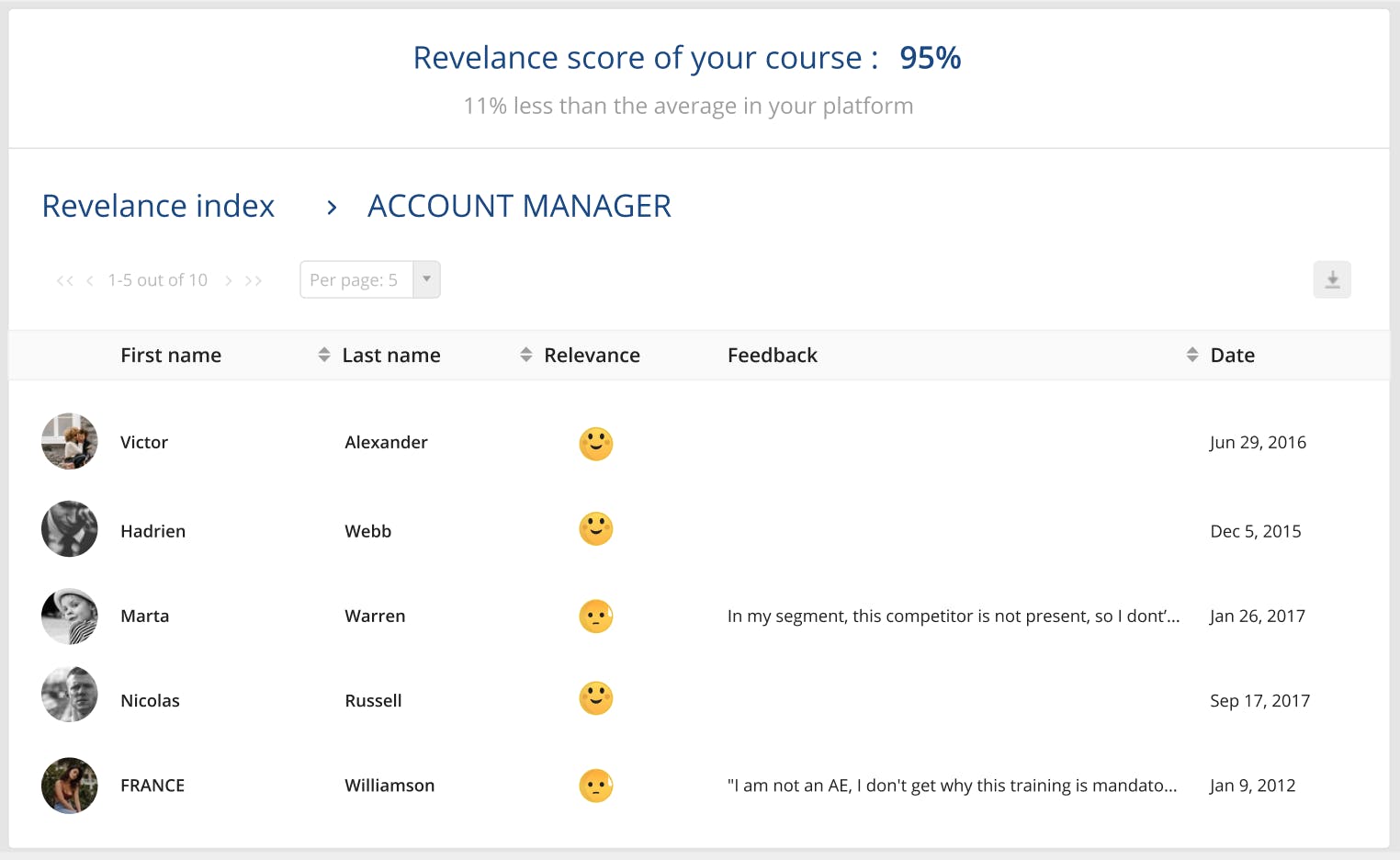“How does this help me?”
When asked to take a training course, that’s usually the first question that pops into every person’s head.
If your learners cannot immediately see the relevance of your training with their day-to-day job, they’ll consider it a waste of their time. And if your learners aren’t engaged, there’s no point to create and ship any training content.
That’s why each activity within a course on 360Learning includes Reactions. With Reactions, learners can quickly express that an activity is useful, confusing, or out-of-date.

Reactions help L&D teams and course authors pinpoint confusing and out-of-date content within a course so you can make updates quickly.
Since the launch of Reactions, our platform has collected over 10 million reactions (!) And that has helped reduce the time and effort training teams spend keeping courses up-to-date.
But we heard from a lot of you that you’d like to take it one step further. Specifically, some of you have asked “How can 360Learning help me capture Kirkpatrick Level 1 feedback for an entire course?”
For those who’re not familiar with the Kirkpatrick Model, it is one of the most commonly used methods for evaluating the effectiveness of training programs. There are four levels to the model, and we’re focusing on level 1.

- Level 1: Reaction —Immediately after training, gauge employee’s reactions. Survey the employees after training to gauge their immediate reactions: How did they feel about training? Did they find the material useful? Was it presented in a clear and helpful way?
Read more: 3 Data-Based Ways To Prove Training ROI (+ Free Training ROI Calculator)
Introducing: Relevance Scores
In response, we launched the Relevance Score across every course, including SCORM courses and third party courses from providers like LinkedIn Learning and Udemy.
When learners finish a course, they are prompted to react to the relevance of the course in one click, like this:

If they indicate that the course wasn’t relevant, they can provide an explanation. You can see the aggregate relevance index with people’s feedback in one place, like this:

It’s been one month since we launched the Relevance Score and we’ve recorded over 244,000 Relevance Reactions! 360Learning clients have an average relevance score of 95%, indicating that L&D teams using 360Learning are shipping courses that are valuable and meet the needs of their learners.
But, what about the other 5%? What’s stopping us from achieving 100% relevance?
Analysis of common training problems from 244,000 relevance reactions
We analyzed the critical feedback across all courses and found four themes that continue to plague even the best training programs. When these problems exist in any part of your training program, it can impact the perception of your entire Learning and Development strategy. That’s why we think it’s time to shake these issues once and for all.
#1: “The training isn’t targeted towards my job”
You may have company-wide training topics, but it’s important that your training is relevant to a given audience. For example, security is a company-wide topic but how it applies to software engineers is different than how it applies to your sales team.
Takeaway: develop and assign role-based courses that match your audience. When it’s a company-wide training, either explicitly state that this training is applicable to everyone regardless of their roles, or explain how each role should apply or use the training in their specific way.
#2: “I’m distracted by mistakes”
We all know that keeping course content up-to-date is essential to ensure training is accurate. But learners tell us there’s another reason: they are distracted by mistakes and even lose trust in training when they spot mistakes in the course content.
Takeaway: use features like Reactions to identify out-of-date content and update accordingly.
#3: “I’m not sure how to apply it”
When building training materials, a lot of us tend to lean on the scholarly side–with a lot of principles, theories, frameworks, and not enough on the practical, hands-on steps.
This problem could be exacerbated when you leverage third-party content that is not specific to how your organization works, or when one central team creates content for the whole company: it is simply impossible for the third-party content or one single team to understand how individual teams work and offer concrete, relevant advice.
Takeaway: co-create courses with each team’s subject-matter-experts so training has immediate application. You should use Kirkpatrick Level 3 feedback to ensure you have the intended behavior impact through training.
#4: “I’m bored”
No one wants to sit through an hour-long training video of PowerPoint slides. Employees expect training to be concise, engaging, and interactive. Information overload can be overwhelming and prompts the question “do I really need to know all of this?” Boredom also creates a barrier to learning, which means learners are unlikely to remember content.
What’s your training relevance score?
Measuring the relevance of your training doesn’t need to take weeks. With our new Relevance Score, L&D teams are measuring course relevancy in real-time and making improvements in minutes. We hope these insights help you increase your impact. When your team is ready to level-up your learning programs through continuous feedback, talk to us.
If you’d like to learn more about our Relevance Score, check out this two-pager, or book a demo with one of our learning experts!


